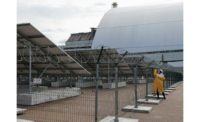The design located the combined-cycle turbine and its associated boiler unit just a few feet from a 50-yr-old, three-story-deep basement with retaining walls that were part of the existing Unit 1 and Unit 2 powerplants. The surrounding earth needed to be able to support a 400-ton crane to lift the equipment, which weighed up to 250 tons—or a total load of 500 tons.
To prevent any side loading to the existing units, "we put in a giant concrete block right next to them," says Chan. The block, nicknamed "Sluggo" by the crew, is 38 ft long by 40 ft wide by 25 ft deep and contains 1,400 cu yd of concrete.
The team had examined other options to stabilize the area, such as augered piles or precast concrete piles. Those solutions would have been adequate for the stationary loads of the final design but would not have stood up to the dynamic loads that would be applied to the soil during construction of the boilers, Rinehart says. Sluggo was "maybe not the most elegant solution," but it worked well to transmit the loads, he adds.
With the site prepped, Kiewit began bringing in the turbines, boiler modules and other heavy power equipment for the combined-cycle and the simple-cycle units. Crews used as many as five crawler cranes and a dozen hydraulic cranes to position the units.
"We've had more crane reconfigurations on this job than any other that I've been on," says Rinehart.
On a typical project, they may only have one or two reconfigurations, he adds. But because of the busy site and the size and weight of the equipment, the cranes' angles and placement had to keep changing.
Chan says it took about three months of night deliveries, special road closures and oversize trailers to bring in all the equipment from Long Beach.
Crews are also constructing 63 different structures, including the 31,200-sq-ft, 15-cell, air-cooled condenser structure and a 14,000 sq-ft, four-story control room with parking, a battery room and offices. To save space, the control room, designed by Ware Malcomb and constructed into a hillside by subcontractor Caliente Construction, does double-duty as a retaining wall. The team also built five permanent roads around the site, totaling about one mile.
The project is on schedule for the units to begin operating in December. By then, crews will have excavated 114,800 cu yd of earth and placed 25,700 cu yd of concrete, 800 tons of structural steel and 1,400 tons of rebar.
LADWP says that over the next five to 15 years, it will replace more than 70% of existing power generation with major investments to modernize its infrastructure, meet renewable energy and energy-efficiency goals and eliminate the use of coal power.













Post a comment to this article
Report Abusive Comment